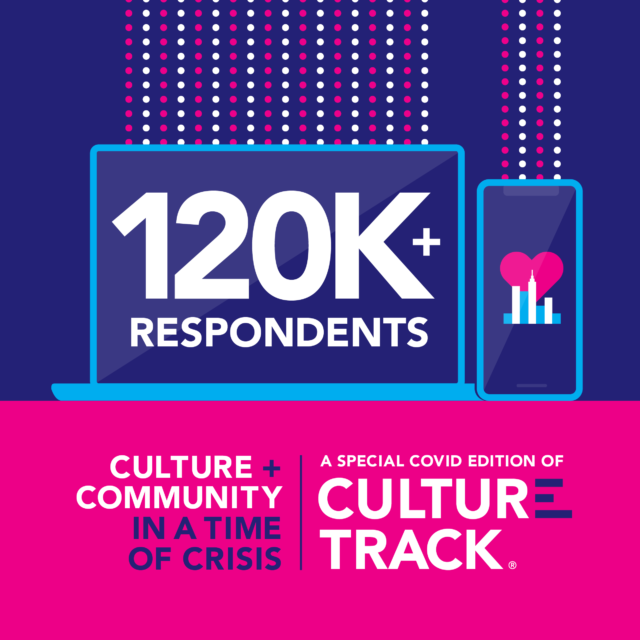News & Notes
An update on the national audience & community study
We are excited to share that we recently closed the first wave of our online survey for Culture & Community in a Time of Crisis: A Special COVID Edition of Culture Track. We received 120,000+ responses from museum goers and arts audiences around the U.S. who were willing to give 20 minutes of their time during these stressful days to share their situations, needs, and plans.
We’ve been nearly overwhelmed logistically and completely floored emotionally. Why?
Because we’d expected a few dozen cultural organizations to include their audiences in the research, and we got interest from 750+ organizations from all 50 states plus DC, Puerto Rico, and two Canadian provinces. (And inquiries from as far as Portugal.) And others are in the queue for Wave 2.
Which means survey invitations were sent out to 2.4 million people in the U.S.— so many people that we had to change our survey launch approach to roll out the survey invitations in waves as to not overwhelm our survey platform and partner in this work, FocusVision. In addition to the 120,000 responses from arts attenders we also received 2,000 general-population responses from NORC’s nationally representation panel, so we have a true national picture of needs, interests, and concerns of the full population in addition to people in the databases of cultural nonprofits.
Size isn’t everything; we didn’t need that large a sample for the big-picture questions we’re aiming to answer. But because this will now be the largest study of cultural participation in the US ever conducted, it’s an unprecedented opportunity to learn about what Americans are going through and what roles culture does — and could — play now and in the future.
Because the median budget size of the organizations involved is $10 million and the lowest-annual-budget organization in the sample is $12,000, we’ll be able to look separately at the audiences of small and non-urban cultural organizations.
Because a subset of the participating organizations are culturally specific and/or serve ALAANA communities, we’ll be able to look closely at the needs and experiences of people of color, rural communities, and other groups that are traditionally underrepresented in arts & culture policy making, planning, and research.
Because so many arts disciplines and museum content-areas are represented in the sample, we’ll be able to see if their audiences differ in relevant ways — and offer strategic insights to each. (That work of recommendations and dialogue will be spearheaded by our other project partner, LaPlaca Cohen, as part of their longstanding national Culture Track initiative.)
And, of course, we’ll take a look at the impact Covid has had, what people’s needs are right now, and where they hope to see arts & culture fit in their life once things return to the new normal.
We’re ready to dive deeply into the data and let our findings guide the story we tell. And we hope this is the first step of many to help the field understand their community. With such a large sample available, what would you be interested to learn? What questions to you have? Let us know and we’ll be bringing you along with us as we release publicly available data. More soon and stay safe.

